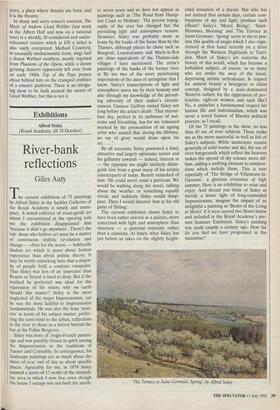Exhibitions
Alfred Sisley (Royal Academy, till 18 October)
River-bank reflections
Giles Auty
The current exhibition of 75 paintings by Alfred Sisley in the Sackler Galleries of the Royal Academy is timely and exem- plary. A noted collector of avant-garde art whom I encountered at the opening told me the exhibition disappointed him 'because it didn't go anywhere'. There's the rub: those who believe art must be a matter of continuous stylistic revolution and change — often for the worse — habitually disdain art which is more about human experience than about artistic theory. It may be worth remarking here that a major- ity of people hold a contrary viewpoint. That Sisley was less of an innovator than Renoir or Seurat is hard to deny. But if the method he perfected was ideal for the expression of his vision, why on earth should this matter? Sisley is the most neglected of the major Impressionists, yet he was the most faithful to Impressionist fundamentals. He was also the least 'mod- ern' in terms of his subject matter, prefer- ring the semi-rural to the urban, reflections in the river to those in a mirror behind the bar at the Folies Bergeres.
Sisley was born of Anglo-French parent- age and was possibly closest in spirit among the Impressionists to the traditions of Turner and Constable. In consequence, his landscape paintings are as much about the times of year and of day as about specific places. Agreeably for me, in 1874 Sisley painted a series of 17 works of the immedi- ate area in which I now live, even though the house I occupy was not built for anoth-
er seven years and so does not appear in paintings such as 'The Road from Hamp- ton Court to Molesey'. The precise topog- raphy of the area has changed but the prevailing light and atmosphere remain. However, Sisley was probably more at home by the banks of the Seine than by the Thames, although places he chose such as Bougival, Louveciennes and Marly-le-Roi are close equivalents of the Thames-side villages I have mentioned. The artist's paintings of the banks of the former river at By are two of the more penetrating impressions of the aura of springtime that I know. Sisley's transcriptions of light and atmosphere move me by their honesty and also through my knowledge of the prevail- ing adversity of their maker's circum- stances. Gustave Geffroy visited Sisley not long before the artist's death: 'That marvel- lous day, perfect in its ambience of wel- come and friendship, has for me remained marked by the premonition of an ageing artist who sensed that during his lifetime, no ray of glory would shine upon his art. .
By all accounts, Sisley possessed a kind, attractive and largely optimistic nature and his gallantry towards — indeed, interest in — the opposite sex might similarly distin- guish him from a great many of his artistic counterparts of today. Renoir remarked of him: 'He could never resist a petticoat. We would be walking along the street, talking about the weather or something equally trivial, and suddenly Sisley would disap- pear. Then I would discover him at his old game of flirting'.
The current exhibition shows Sisley to have been rather uneven as a painter, more concerned with light and atmosphere than structure — a pictorial romantic rather than a classicist. At times, what Sisley has put before us takes on the slightly height-
ened sensation of a dream. But who has not noticed that certain days, certain com- binations of sky and light, produce such effects? Sisley's `Moret Bridge', 'Saint- Mammes, Morning' and 'The Terrace at Saint-Germain : Spring' seem to me to pos- sess this quality of magic which I also expe- rienced at first hand recently on a drive through the Western Highlands to Toni- don. Much of Sisley's art concerns the beauty of this world, which has become a forbidden subject, of course, to so many who are under the sway of the latest, depressing artistic orthodoxies. Is respect for natural beauty a bourgeois or elitist concept, designed by a male-dominated Western culture for the oppression of pro- letarian, right-on women and such like? No, it underlies a fundamental respect for human life and individualism, which was never a noted feature of Marxist political practice, as I recall.
Of the 75 paintings in the show, no less than 45 are of river subjects. These strike me as the more successful as well as felt of Sisley's subjects. While landscapes consist generally of solid matter and sky, the use of river foregrounds which reflect the heavens makes the spread of sky colours more dif- fuse, adding a unifying element to composi- tions which include them. This is true especially of 'The Bridge of Villeneuve-la- Garenne', a glorious evocation of high summer. Here is an exhibition to relax and enjoy. And should you think of Sisley as merely a lesser light of long-outmoded Impressionism, imagine the impact of so delightful a painting as 'Banks of the Loing at Moret' if it were moved two floors below and included in the Royal Academy's pre- sent Summer Exhibition. Sisley's painting was made exactly a century ago. How far do you feel we have progressed in the meantime?
The Terrace at Saint-Germain: Spring', by Alfred Sisley


















































 Previous page
Previous page